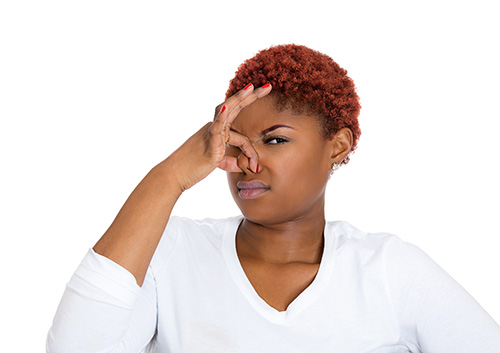April 27th, 2022

Nobody likes bad breath, and although it can sometimes be difficult to tell if you have it, it is always better to practice good oral health than risk having a smelly mouth. There are many ways to reduce or eliminate bad breath, some are definitely more effective and longer lasting than others. Check out ways to do so below.
Floss Regularly
As difficult as it can be to remember to floss regularly, when it comes to bad breath, flossing is one of the easiest and most cost effective ways to freshen your mouth. See, flossing reduces the plaque and bacteria found in areas of your mouth that a toothbrush simply can't reach, and in turn, it rids your mouth of the smell associated with that bacteria. While flossing may not eliminate bad breath on its own, if you do it along with other health oral hygiene habits like brushing, then you may just develop a fresher smelling mouth.
Use Mouthwash
Using some sort of mouthwash can really freshen up your breath, especially if you find it still smells after brushing and flossing. There is a wide variety of mouthwash products on the market, however, you can also create your own by simply using baking soda mixed with water.
Always Brush after You Sleep
Whether after taking a nap, or having a full night of sleep, you will want to brush your teeth in order to reduce bad breath. The truth is, bacteria accumulates in your mouth while you are sleeping (even during a short nap) and that is ultimately the source of bad breath. So next time you wake from a good slumber, give your mouth some brushing and you will find it makes a big difference in the freshness of your breath.
There are many ways to freshen your breath beyond just using gum or mints, the above mentioned are just a few for you to try. Test them out and you will likely find your bad breath problem is solved, or at least considerably reduced. Of course, you can always ask Dr. Zoka at your next visit to our Camarillo, CA office.
April 20th, 2022

Also known as onchophagia, the habit of nail biting is one of the so-called “nervous habits” that can be triggered by stress, excitement, or boredom. Approximately half of all kids between the ages of ten and 18 have been nail biters at one time or another. Experts say that about 30 percent of children and 15 percent of adults are nail biters, however most people stop chewing their nails by the time they turn 30.
Here are four dental and general reasons to stop biting your nails:
1. It’s unsanitary: Your nails harbor bacteria and germs, and are almost twice as dirty as fingers. What’s more, swallowing dirty nails can lead to stomach problems.
2. It wears down your teeth: Gnawing your nails can put added stress on your pearly whites, which can lead to crooked teeth.
3. It can delay your orthodontic treatment: For those of our patients wearing braces, nail biting puts additional pressure on teeth and weakens roots.
4. It can cost you, literally: It has been estimated that up to $4,000 in extra dental bills can build up over a lifetime.
Dr. Zoka and our team recommend the following to kick your nail biting habit:
- Keep your nails trimmed short; you’ll have less of a nail to bite.
- Coat your nails with a bitter-tasting nail polish.
- Ask us about obtaining a mouthguard, which can help prevent nail biting.
- Put a rubber band around your wrist and snap it whenever you get the urge to gnaw on your nails.
- Think about when and why you chew your nails. Whether you are nervous or just bored, understanding the triggers can help you find a solution and stop the habit.
- If you can’t stop, behavioral therapy may be an effective option to stop nail biting. Ask Dr. Zoka and our team for a recommendation.
April 13th, 2022

If Dr. Zoka and our team recommend a Hawley retainer to complete your orthodontic treatment, you’re getting a classic. This retainer, invented by Dr. Charles Hawley, has been in use since the early decades of the twentieth century.
But this isn’t your great grandmother’s pink plastic retainer! The look of today’s Hawley retainer has really evolved from its early days as the “Hawley bite plate”—and pink is now a choice instead of an inevitability. In fact, you can choose from any number of colors, patterns, and designs to create a retainer that is uniquely you.
Each Hawley retainer is customized to fit your mouth and teeth perfectly. Wire clasps and a labial bow wire are securely attached to an acrylic base based on a model made from your teeth and mouth.
Your retainer is designed for function—the bow wire makes sure your teeth stay in the perfect position while your bones and ligaments get strong enough to hold them in place. The acrylic base, of course, is also functional—but that doesn’t mean you can’t have fun with it!
Retainer bases can be formed in different ways. One type of retainer model uses pre-formed acrylic discs for the base, and these are available in many pre-formed colors and patterns. Another type of retainer builds the base by alternating several applications of liquid and powder acrylics, layer after layer. This process allows the retainer technician to create one-of-a-kind designs.
What are some of the ways to make your retainer uniquely yours?
- Color—whether deep tones, pastels, electrics, neon, or metallic, you can find an appealing shade in the color chart. Or, if you want your retainer to keep a low profile, choose a clear or a color-coordinated pink tone.
- Glow in the Dark—if you don’t want your retainer to keep a low profile, this might be just the look for you!
- Glitter—accessorize your sparkling smile with a sparkling retainer.
- Patterns—stripes, polka dots, geometric shapes—even animal patterns are possible.
- Color Combinations—why choose one color when you can have a marbled swirl of your favorites? Or a tie-dye look? Or team colors?
- Acrylic Designs—a colorful design that captures your personality is available with some creative acrylic artistry. Rainbows and flags, hearts and flowers, ladybugs, and spider webs are just some of the options on hand.
- Picture Perfect—for that special hobby, pet, team, or other personal favorite, decals or pictures can be applied under a layer of clear acrylic.
Hawley retainers are made to last, so choose your design with years of use in mind. Talk to our Camarillo, CA team about the custom looks which are available to celebrate your unique personality. After all, there’s nothing more personal than your smile!
April 6th, 2022

Do you ever find yourself gnawing at your nails? Nail-biting is a very common and difficult to break habit which usually has its beginnings in childhood. It can leave your fingers and nail beds red and swollen. But if you think that your nails are the only ones getting roughed up by nail-biting you'd be mistaken—so are your teeth!
According to a study by the Academy of General Dentistry, those who bite their nails, clench their teeth, or chew on pencils are at much higher risk to develop bruxism (unintentional grinding of the teeth). Bruxism can lead to tooth sensitivity, tooth loss, receding gums, headaches, and general facial pain.
Those are some nasty sounding side effects from chewing on your nails. Most nail-biting is a sign of stress or anxiety and its something you should deal with. So what steps can you take if you have a nail-biting habit?
There are several things you can do to ease up on nail-biting:
- Trim your nails shorter and/or get regular manicures – Trimming your nails shorter is an effective remedy. In so doing, they'll be less tempting and more difficult to bite on. If you also get regular manicures, you’ll be less likely to ruin the investment you’ve made in your hands and fingernails!
- Find a different kind of stress reduction – Try meditation, deep breathing, practicing qigong or yoga, or doing something that will keep your hands occupied like squeezing a stress ball or playing with a yo-yo.
- Wear a bitter-tasting nail polish – When your nails taste awful, you won't bite them! Clear or colored, it doesn't matter. This is also a helpful technique for helping children get over the habit.
- Figure out what triggers your nail-biting – Sometimes it's triggered by stress or anxiety and other times it can be a physical stressor, like having hang nails. Knowing what situations cause you to bite your nails will help you to avoid them and break the habit.
- Wear gloves or bandages on your fingers – If you've tried the steps above and they aren't working, this technique can prove effective since your fingernails won't be accessible to bite.
If you're still having trouble with nail-biting after trying these self-help steps, it's best to consult your doctor, dermatologist, or Dr. Zoka. For some, it may also be the sign of a deeper psychological or emotional problem.
Whatever the cause, nail-biting is a habit you need to break for your physical and emotional well-being. If you have any questions about the effects it can have on your oral health, please don't hesitate to ask Dr. Zoka during your next visit to our Camarillo, CA office.





 Website Powered by Sesame 24-7™
Website Powered by Sesame 24-7™